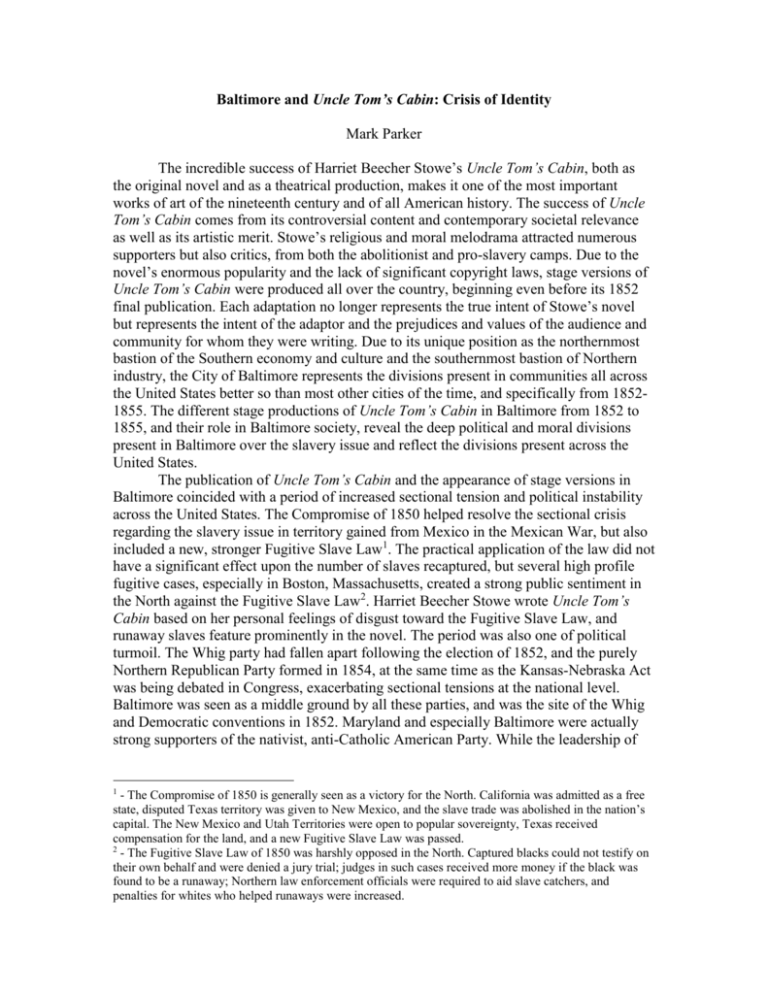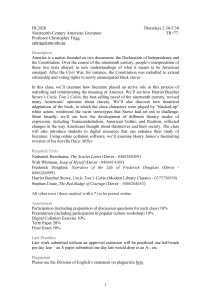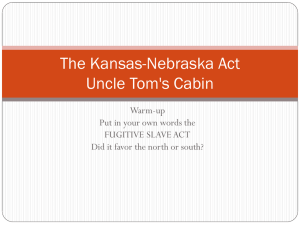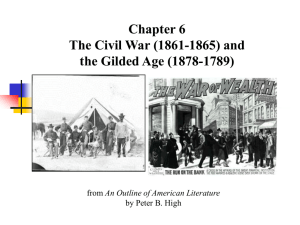printable version (Word format).
advertisement

Baltimore and Uncle Tom’s Cabin: Crisis of Identity Mark Parker The incredible success of Harriet Beecher Stowe’s Uncle Tom’s Cabin, both as the original novel and as a theatrical production, makes it one of the most important works of art of the nineteenth century and of all American history. The success of Uncle Tom’s Cabin comes from its controversial content and contemporary societal relevance as well as its artistic merit. Stowe’s religious and moral melodrama attracted numerous supporters but also critics, from both the abolitionist and pro-slavery camps. Due to the novel’s enormous popularity and the lack of significant copyright laws, stage versions of Uncle Tom’s Cabin were produced all over the country, beginning even before its 1852 final publication. Each adaptation no longer represents the true intent of Stowe’s novel but represents the intent of the adaptor and the prejudices and values of the audience and community for whom they were writing. Due to its unique position as the northernmost bastion of the Southern economy and culture and the southernmost bastion of Northern industry, the City of Baltimore represents the divisions present in communities all across the United States better so than most other cities of the time, and specifically from 18521855. The different stage productions of Uncle Tom’s Cabin in Baltimore from 1852 to 1855, and their role in Baltimore society, reveal the deep political and moral divisions present in Baltimore over the slavery issue and reflect the divisions present across the United States. The publication of Uncle Tom’s Cabin and the appearance of stage versions in Baltimore coincided with a period of increased sectional tension and political instability across the United States. The Compromise of 1850 helped resolve the sectional crisis regarding the slavery issue in territory gained from Mexico in the Mexican War, but also included a new, stronger Fugitive Slave Law1. The practical application of the law did not have a significant effect upon the number of slaves recaptured, but several high profile fugitive cases, especially in Boston, Massachusetts, created a strong public sentiment in the North against the Fugitive Slave Law2. Harriet Beecher Stowe wrote Uncle Tom’s Cabin based on her personal feelings of disgust toward the Fugitive Slave Law, and runaway slaves feature prominently in the novel. The period was also one of political turmoil. The Whig party had fallen apart following the election of 1852, and the purely Northern Republican Party formed in 1854, at the same time as the Kansas-Nebraska Act was being debated in Congress, exacerbating sectional tensions at the national level. Baltimore was seen as a middle ground by all these parties, and was the site of the Whig and Democratic conventions in 1852. Maryland and especially Baltimore were actually strong supporters of the nativist, anti-Catholic American Party. While the leadership of 1 - The Compromise of 1850 is generally seen as a victory for the North. California was admitted as a free state, disputed Texas territory was given to New Mexico, and the slave trade was abolished in the nation’s capital. The New Mexico and Utah Territories were open to popular sovereignty, Texas received compensation for the land, and a new Fugitive Slave Law was passed. 2 - The Fugitive Slave Law of 1850 was harshly opposed in the North. Captured blacks could not testify on their own behalf and were denied a jury trial; judges in such cases received more money if the black was found to be a runaway; Northern law enforcement officials were required to aid slave catchers, and penalties for whites who helped runaways were increased. Baltimore was vocally Southern, the population was only moderately so, and the city had strong economic ties with both North and South. The citizens of Baltimore formed one of the most diverse populations in the nation. Slave-owning merchants and planters lived with their slaves in the city alongside abolitionist, Quaker merchants and free blacks, members of the largest free black community in the United States. As the third-largest city in the United States, Baltimore was a very important and the only Southern city on the northeastern theatre circuit, which ran from Boston through New York, Philadelphia, Baltimore, and Washington, D.C. Baltimore was also a popular destination for Southern companies touring throughout the region. Some Baltimore theatres operated a colored gallery for free black and possibly slave theatergoers (with their master’s permission), which is not a common practice in the North. Baltimore was therefore a fertile ground for a wide variety of Uncle Tom’s Cabin productions, and from 1852 to 1855 these shows represented the major interpretations seen across the national stage. Stowe originally published Uncle Tom’s Cabin serially, and first stage productions of the novel occurred in January, 1852, before the novel had been completely published. One source states that “the first known stage version, Uncle Tom’s Cabin as it is; or, The Southern Uncle Tom, was performed at the Baltimore Museum on January 5, 1852,”3 but careful study of theatre advertisements and reviews in Baltimore’s The Sun newspaper does not indicate that such a production took place. Such a production is completely logical, however, for Baltimore theatre managers would have been eager to make money from the success of Stowe’s novel, which would not finish publication until April of the same year. From the title of the production, this version is along the lines of the traditional Southern interpretation, which takes the character of Uncle Tom and portrays him as a happy, carefree slave comfortable with his enslavement, and supporting the system of slavery as that which is best for the Negro race. The majority of Uncle Tom shows in Baltimore were not produced until after the run of the George Aiken script production at the National Theatre in New York, which ended a 325-performance run on May 13, 1854. The first serious staging of Uncle Tom’s Cabin around this time in Baltimore was the production at the Charles St. Theatre, beginning June 30, 1854. The advertisement for the production states, on the specific evening, that there “will be presented the thrilling, moral and religious drama entitled “Uncle Tom’s Cabin,” or Life Among the Lowly, written expressly for this theatre.”4 While this script was written expressly for the Charles St. Theatre, as were most of the productions in the years immediately following the publication of the novel, the interpretation is much different from that of the supposed first production in Baltimore. The scripts varied from production to production across the nation, spread along a scale from “religious and moral” to pro-slavery and minstrel adaptations. The novel itself is in essence a religious and moral American melodrama focusing on the evils of slavery, as other works focused on alcoholism or infidelity. By advertising a “moral and religious drama,” the script is presumably nearly faithful to the original novel, at least in terms of - Drummond, A.M. and Richard Moody, “The Hit of the Century: Uncle Tom’s Cabin— 1852-1952,” Educational Theatre Journal 4, no. 4 (1952): 316. 4 - —, The Sun. ? (1 July 1854), 3. As a point of information, The Sun did not use bylines until well into the twentieth century, believing that what was important was the continuity and quality of the news and analysis provided, not the individual glory of the writers. A. S. Abell was the longtime editor. 3 overall message and presentation of the main ideas and characters. The advertisement does not advocate a particularly sectional ideology, as did the earlier production, but casts the show in terms of moral and religious value. It did so to appeal to a middle class obsession with the public welfare and social reform, although these movements were weaker in Baltimore, with its diverse class and racial mix, than in Northern cities whose population groups were more easily defined. Also, the theatre manager might avoid some public outcry by advertising this show as a moral and religious drama as opposed to an abolitionist drama, a message hostile to the personal lifestyle of many Baltimore theatergoers. The Sun commented on the fine acting of the Uncle Tom character as well as that of Topsy, and reserved special praise for the young actress who played Eva5, and did not comment on the abolitionist content of the show at all, which holds true throughout most of its reviews. The show ran for around twenty days, with three shows on the Fourth of July, and both from its success and the lack of negative comment concerning it, the production shows that there was a viable market for Aiken-like scripts in Baltimore, despite its Southern heritage and the existence of slavery in the state. The Aiken production, after its record-breaking run at the National Theatre in New York, went on a tour of the northeastern theatre circuit. After playing in Boston and Philadelphia, the most famous cast and production of Uncle Tom’s Cabin, up to that point, came to Baltimore. The production, starring Mr. and Mrs. Howard as St. Clair and Topsy, and little Cordelia Howard as Eva, played at Owen’s Charles St. Theatre, just as the earlier production did, from April 16 to May 19, 1855. Owen played the role of Uncle Tom. The show was highly anticipated and well received by the Baltimore audience. The Sun reports the following about the show: Uncle Tom’s Cabin was produced on Monday…to a full and fashionable house. The parts of Topsy, St. Clair, and Marks…elicited great applause, while…Uncle Tom excelled himself. But the gem of the evening was the performance of Eva…whose exquisite pathos drew tears from many eyes.6 The Aiken script is generally considered the best and most popular stage adaptation of Uncle Tom’s Cabin, and with a few changes remains relatively true to the Stowe novel. The success of this version before a Baltimore audience, a large audience made up of many members of the upper class, indicates the level of tolerance and maturity of the population of Baltimore. Even though many of the most “fashionable” people would be slave owners, this did not preclude them from going out to the theatre with their nonslaveholding friends and watching a show with an abolitionist theme. Just as with the earlier Baltimore version that was close to the novel, perhaps the Aiken script avoided controversy and negative comment in the newspaper because it cast itself as a moral melodrama, like The Drunkard, and not abolitionist propaganda. Aiken’s version changed Topsy into an amusing minstrel character, which had the effect of lightening the tone of the show and providing comic relief amidst the seriousness of the other events. The Baltimore audience, in spite of being Southern and slave-holding, was still receptive to faithful versions of Uncle Tom’s Cabin, and raised no serious public outcry against them. 5 6 - —, The Sun. ? (1 July 1854), 2. - —, The Sun. 36, no.131 (18 April 1855), 2. The first Baltimore production of Uncle Tom’s Cabin advertised itself as the Southern Uncle Tom, and attempted to represent the author’s perception of the reality of the slave system in the 1850s. Many later Baltimore productions also represented the Southern attitude towards the novel, most notably through the form of minstrel shows. Even the Aiken version included Topsy as a minstrel character, who got into mischief, danced breakdowns, and was unaffected by the whippings inflicted upon her. Baltimore minstrel shows either incorporated Uncle Tom characters into their regular acts, or produced entire shows satirizing Uncle Tom’s Cabin and attempting to show what the Southern slave system was really like. Kunkel’s Nightingale Opera Troupe, also known as Kunkel’s Ethiopian Opera Troupe, was a minstrel troupe operating out of Baltimore in the years following the publication of the novel, and they toured the entire South performing their Rebuke to Uncle Tom’s Cabin before large audiences in Washington, DC, Richmond, Tennessee, and Kentucky. The Sun commented on the success of this “admirable production”7 and noted that the writer and producer was John T. Ford, the same Ford who would later open Ford’s Theatre where President Lincoln was assassinated. Kunkel’s minstrel rebuttal to Uncle Tom’s Cabin was performed in the Maryland Institute Hall from June 12 to June 27, 1854. At this point there was no direct antagonism between pro-slavery and anti-slavery productions, and none of them had been staged concurrently in Baltimore. By early July, however, the situation was much more tense, as the minstrel version of Kunkel’s Troupe played at the Maryland Institute while the “moral and religious drama” of Uncle Tom’s Cabin played at the Charles St. Theatre. Ford began running advertisements stating “[see] the Real Happy Uncle Tom at the Maryland Institute,”8 promoting “the truth of slavery,”9 and warning readers to “look out for the nigger who sold himself to the Devil; Uncle Tom’s Cabin performed nightly.”10 Advertisements for the minstrel and melodrama versions of the novel appeared next to each other in the newspaper. Yet, even though the shows were competing for the attention of Baltimore audiences, The Sun did not take either side in the debate, nor did it report any disturbances as a result of the competing shows. The same thing happened when Christy’s Minstrels visited Baltimore from their New York home, and included the “Happy Uncle Tom’s Dance”11 as part of their act, while the Aiken version of the novel was being performed at the Charles St. Theatre. Baltimore, unlike other parts of the nation, was able to separate its theatre from its controversial politics because Baltimore society was extremely conscious and wary of anything that upset the social and political balance in the city. Minstrel and Southern adaptations of Uncle Tom’s Cabin coexisted relatively peacefully with Northern, melodramatic adaptations on the Baltimore stage because the diversity of Baltimore’s population curbed any tendency in the population to support one version over another. The situation of Baltimore, between North and South politically, culturally, and economically, the diversity of its population, and the variety of viewpoints of its citizens allowed all adaptations of Uncle Tom’s Cabin to be performed without problems, from the most unabashedly abolitionist to the most appalling minstrel burlesque. The only - —, The Sun. ? (1 June 1854), 2. - —, The Sun. 35, no. 42 (6 July 1854), 3. 9 - —, The Sun. 35, no. 55 (19 July 1854), 3. 10 - —, The Sun. 35, no. 48 (12 July 1854), 3. 11 - —, The Sun. 36, no. 123 (10 April 1855), 3. 7 8 concrete rule in Baltimore theatre was the importance of money and success over the content of the shows. Shows were either good or bad, interesting or boring. Any theatre could milk the name of Uncle Tom for as much as it was worth, and they did. For example, beginning on November 14, 1853, “Uncle Pat’s Cabin” was produced at the Baltimore Museum. Here is the newspaper description: The new drama, written for Mr. And Mrs. B. Williams, entitled “Uncle Pat’s Cabin,” which has been performed in Philadelphia and New York to crowded houses, will be produced this evening. Mr. Williams performs the part of Micky Malone, and Mrs. Williams that of widow Casey. It portrays, in a vivid manner, the wrongs and misfortunes endured by the people of that beautiful but misgoverned country [Ireland] and is replete with thrilling interest…Uncle Pat’s Cabin is having an unexampled run at this favorite house. On each night of its performance hundreds are unable to gain admittance.12 Uncle Tom’s Cabin became so much more than a play, or a novel; it became an American icon, both within the nation and overseas, and nothing that Stowe could do would stop it from being used to amuse audiences or highlight the oppression of the Irish people. The name, the idea, had power, to be used in whatever way a producer, artist, or politician desired. It was an engine for social and political commentary, to be used by all sides to represent their perspective on the slavery issue and racism in general. This might seem good, but it actually is not because it does not prompt societal dialogue (based on reading the same book, or watching the same play), but polarizes the population and kills any debate, as well as the opportunity for compromise and societal growth. This did not occur in Baltimore, because there were so many different groups of people and ideas that Baltimore society could not support a single adaptation of Uncle Tom’s Cabin. But the danger was on the national level, where debate and opinions quickly polarized into proslavery versus anti-slavery and South versus North. This national polarization killed the chance for any debate as well as the opportunity for compromise and societal growth as a nation. By having different versions of the play, the imagined community that is the United States is being split apart. If people’s concepts of society, their imagined American communities, are fundamentally different, separate, and hostile to each other, then the actual society cannot long endure without splitting in two or purging itself of its inherent contradictions. The Astor Place Riot was a result of the contradictions between the imagined community of the Bowery Boys and the imagined community of the New York elite13, and the Civil War stemmed partly from the contradictions between the imagined community of the North, without slaves and full of immigrants and factories, and the slave-holding, plantation system imagined community of the South. Baltimore society did not suffer the same result as American society as a whole, civil war, because - —, The Sun. 33, no. 45 (14 November 1853), 2. - On May 10, 1849, a crowd of 10,000 to 15,000 people rioted outside the Astor Place Opera House in New York City. Although the apparent cause of the riot was a feud between American actor Edwin Forrest and English actor William Macready, the underlying causes are more important. The riot drew from deep divisions within New York society, class conflict between Astor Place elite and working class “Bowery Boys,” after the working class Bowery Theatre, and a frustration over the lack of a purely American cultural identity, distinct from the hated English. 12 13 Baltimore has its own distinct imagined community, from the diversity of its population, politics, and economics, that allows stage versions of Uncle Tom’s Cabin to promote social welfare instead of social unrest. Bibliography Abell, Arunah S., ed. The Sun. Baltimore: A.S. Abell &Company, 1852-1855. 33, no. 45 through 36, no 131. Adams, F.C. A Review from Home: In Answer to the Reviewers and Repudiators of Uncle Tom’s Cabin. Freeport: Books for Libraries Press, 1853. Birdoff, Harry. The World’s Greatest Hit: Uncle Tom’s Cabin. New York: Vanni, 1947. Cerf, Bennett. The Most Successful Plays in the History of the American Stage. Garden City: Garden City Publishing Co., 1946. Clark, Susan F. “Solo Black Performance before the Civil War: Mrs. Stowe, Mrs. Webb, and The Christian Slave.” New Theatre Quarterly 13, no. 52 (1997): 339-348. Drummond, A.M. and Richard Moody. “The Hit of the Century: Uncle Tom’s Cabin— 1852-1952.” Educational Theatre Journal 4, no. 4 (1952): 315-322. Lowance, Mason I. Jr. Ellen Westbrook, and R.C. De Prospo. The Stowe Debate: Rhetorical Strategies in Uncle Tom’s Cabin. Amherst: University of Massachusetts Press, 1994. Miller, Tice L. and Don B. Wilmeth. Cambridge Guide to American Theatre. Cambridge: Cambridge University Press, 1996. Moses, Montrose Jonas and John Mason Brown, eds. The American Theatre as Seen by its Critics. New York: W.W. Norton & Company, inc., 1934. Samuels, Shirley. The Culture of Sentiment: Race, Gender, and Sentimentality in Nineteenth-Century America. New York: Oxford University Press, 1992. Stearns, Rev. Edward J. Notes on Uncle Tom’s Cabin: Being a Logical Answer to its Allegations and Inferences Against Slavery as an Institution. Philadelphia: Lippincott, Grambo & Company, 1853.







